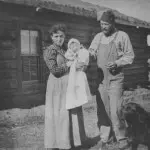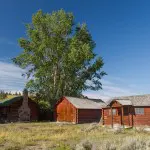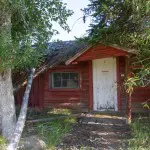In 1870, Emile Wolff emigrated from his native Belgium to the United States. He enlisted in the Army, and was stationed at Fort Hall in Idaho. During his service he ventured into Jackson Hole to deliver supplies to the doomed Lt. Gustavus C. Doane* expedition. Despite the foul winter weather, Wolff was impressed by the small valley. Upon his discharge, he began homesteading in Teton Valley, Idaho. Here he became involved with another infamous Jackson Hole story, still told around the campfire. He made the acquaintance of four other German immigrants, one of whom had gone to school with Wolff. The four men were inquiring after supplies they needed for gold panning on the Snake River in Jackson Hole. Wolff directed them towards a neighbor, and wished them luck. Later that summer, Wolff was about to begin haying when he was startled to view a man on foot coming across his fields. Horses were the primary mode of transportation, so the approach was unusual, but not unheard of. When the figure got closer, Wolff recognized him as John Tonnar, one of the four gold prospecting Germans he had encountered earlier in the year. Wolff was surprised to see Tonnar again, who asked for work and a place to sleep. Acquiescing, Wolff asked many questions about Tonnar’s former partners and got only “unsatisfactory” answers. There was plenty of work to be done with haying, and Wolff was more glad to have the assistance rather than question Tonnar’s unusual manners.
A month later, a sheriff and a posse came upon Wolff at home while Tonnar worked out in the field. The sheriff informed Wolff that they had found Tonnar’s three partners murdered and buried under rocks in the Snake River. Wolff was aghast that he had harbored a man capable of murder, and sent the posse into the field after Tonnar. He was captured and brought to court, while Wolff was sent to identify the bodies. After a confirmation that they were the same men Tonnar had been with earlier that summer, a trial in Evanston began. Despite all of the evidence stacked against him, Tonnar was acquitted. It was determined that due to no witnesses, the evidence was only circumstantial. Tonnar then disappeared, and many theories abound as to his guilt and his future. Today, the bend of the River where the three men were discovered is known as “Deadman’s Bar.” Despite these events, Wolff packed up and moved to Jackson Hole where he homesteaded along Flat Creek, adjacent to the Robert Miller homestead. Miller was another character whose reputation is larger than the man. His reported early involvement with local outlaw Teton Jackson and later involvement with John D. Rockefeller, Jr. and the Snake River Land Company cause a lot of disagreement over his true intentions. He did open the first Bank of Jackson Hole and his wife, Grace, was Mayor for several years.
Finding success on Flat Creek, Wolff began looking for a homestead that was farther from the bustle of town. After lands opened up along Spread Creek, in the northern half of the valley, Wolff jumped on a homestead claim. Just south of the future Elk Ranch, Wolff had quality land and easy access to water. He dug a ditch from Spread Creek himself, and received a patent for his homestead in 1906. Prior to this, he briefly returned to Belgium in order to find a wife and married Marie Bettendorff in 1893. Despite their advantageous location, the Wolff Ranch was run within the limits of the original 160 acre homestead. The Wolffs were rare in the valley in that they were successful, but not looking to expand. They also never sold out to their neighbors on the Elk Ranch who expanded quickly. When the Snake River Land Company came knocking in the 1920s, the Wolffs declined the offer to sell. It was obvious that they took great pride in their home, and maintained a modesty that would continue to define the property. To bring in more cash, Marie operated the Elk Post Office for 17 years and Emile sold furs that he trapped. He would also become one of the first Forest Rangers in the valley.
In 1913, Emile Jr. was born in Luxembourg (Marie made sure her children were born in Belgium to ensure their qualification for an inheritance from her family). This proved more expensive in terms of travel than the final inheritance that came their way. Emile, Jr. was better known by the family as “Stippy.” He attended the local school at Elk, and assisted with various ranch chores. In addition to his formal schooling, he began violin lessons at the age of seven. His mother was a skilled singer, and his father had acquired the old piano from John Sargent’s Merymere in Moran. The family became known in the valley for their talent and often played at the many community gatherings. Despite loving the ranch, and the life that came with it, Stippy was never much of a rancher. After his father’s death in 1928, he continued to live on the ranch and assist his mother with chores but he earned a living working odd jobs throughout the valley.
Stippy’s decision not to become a full rancher was probably due in part to the fact that the family’s small 160 acre property was unable to produce much cash flow as the operation so small. Now in the 20th century, cash and business acumen were increasingly in-demand. The family continued playing music at nearly every dance hall and dance event around the valley. In the 1930s offers by visitors and area officials to purchase the small ranch were vehemently rebuffed by Marie Wolff. The family held no official stance on the subject of park expansion or federal government involvement, probably due to their ranch being located on the eastern boundary of Jackson Hole. Despite being adjacent to the Elk Ranch, which was run by the Snake River Land Company, the Wolffs head fast to their land.
In the 1940s, many changes would continue to form the Wolff Ranch. Stippy married Beryl Adams and in 1941, they were deeded one acre from Marie on which to build their house. During World War II, Stippy was called away to work in defense construction. When he returned, the ranch was transitioning away from running cattle to hosting tourists. With the majority of the valley now protected under the Jackson Hole National Monument, grazing options were limited and beef prices were no longer sustainable for such a small ranch. During this time dude ranching and extended family vacations out west were highly desirable. With the majority of Europe recovering from the war, many Americans were turning their sights inward to celebrate the beautiful spaces their own county had to offer. The valley had a long history of dude ranching, and by the 1940s this had evolved into shorter stays and looser requirements for guests. Prospective guests no longer had to request a letter of recommendation from a mutual friend of the ranch owner, nor did one have to provide references on the personality of their family. The Wolffs saw an opportunity to offer small overnight cottages, offering the advantage of overnight stays. The rest of the valley was transitioning away from the traditional weeks-long dude ranch stay to accommodate families who wanted to see and do as much as possible. The construction of U.S. Highway 89, the Wolff Ranch was now directly on of the main transportation routes in the valley.
In 1954, Marie Wolff died and the property passed to Stippy, his brother Willie and two sisters. They expanded the small motor court (as they were called, a small circle of cottages with parking out front for automobiles) and added a gas pump. The old main ranch house became a dining room and kitchen. Stippy and Beryl ran the majority of the business, with Beryl having the primary responsibility. The family business continued to be popular until the 1970s when small roadside motor courts were declining in favor of large hotel-based resorts. The construction of the Jackson Lake Lodge and Colter Bay campground near Moran drew a lot of the Wolffs’ former clientele away. In 1978 Stippy and Beryl sold the ranch to the National Park Service in return for a lease that would terminate on December 31, 1999. Sadly, in 1988 Stippy would meet an early death in a logging accident, and Beryl remained on the property for only a year after that. The winters were becoming difficult to bear, and she spent most of her time in town. In another twist of fate, she died on January 3, 2000 only days after the lease had ended and the property formally transferred to Grand Teton National Park.
*Doane had commissioned the expedition hoping to become famous. Despite the Snake River having already been surveyed, Doane was seeking the fame of the earlier Hayden expeditions. His hubris caused him to overlook details like bringing enough supplies for the rugged terrain and underestimating the harshness of winter. The expedition nearly starved to death and required rescue and immediate recall to Fort Ellis.
Text by Samantha Ford, Director of Historical Research and Outreach



